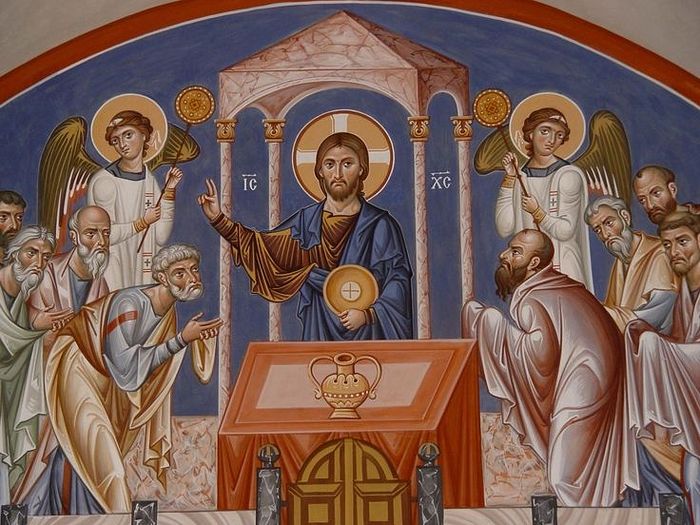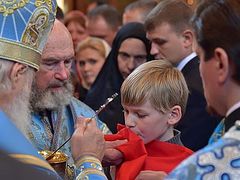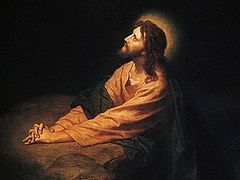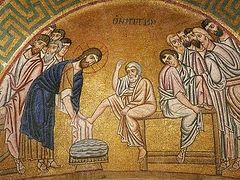The Rite of Divine Liturgy in its most basic form—reading the Holy Scriptures, prayers for the living, prayers over the Gifts, and finally, Holy Communion—had already taken shape in the first century.
The majority of the prayers and priestly actions entered into the rite of the Liturgy by the sixth century. Further development of the Liturgical rite was associated with the refinement of the expression of our faith in connection with historical conditions and heterodox influence. Below, historical information is presented on the development of certain parts of the Liturgy in order to give a more meaningful picture of what is happening during the main service of the Orthodox Church.
The Liturgy of the Word
-
Great Litany—from the eleventh century. In the petition for the Primate of the Church, the Church of Greece commemorates only the local Bishop, and not the entire Holy Synod, following the principle of submission to one (their own, local) bishop.
-
The Antiphons—all three from the eighth century. There were different ones for weekdays and Sundays.
-
The Trisagion—the Holy Fathers mentioned it from the fourth century; it was part of the Liturgy from the fifth century, and it reached its unchanged form by the sixth century.
-
The exclamation “Lord save the pious” was a patriarchal glorification of the emperor. A similar form can be found by 1580. In Greece, from the eighteenth century, and in the Russian Orthodox Church, it was practiced exclusively during hierarchical liturgies. However, in priestly service books,1 this exclamation appeared on the territory of South-Western Rus’2 from the seventeenth century;3 in Moscow, it began to be used from 1655. During the Soviet era, the exclamation was excluded from use, due to its origin from the glorification of the emperor. In practice, it began to be used between 1970–1980. Since 1990, it was present at both hierarchical and priestly liturgies. Since 1996 it entered into the service book.4
-
The Alleluia [after the Epistle reading] is first encountered in a seventh-century Georgian lectionary compiled in Jerusalem. In Rus’ it began to be used between the eleventh and twelfth centuries. Its function is the same as the Prokeimenon, to draw focus on the Word of God. The censing [with incense] during the reading of the Epistle in the twelfth to thirteenth centuries, led to the decline of the reading of the Alleluia in the Greek Church.
-
The Augmented Litany [Litany of Fervent Supplication] is known from the “Apostolic Constitutions” (third to fourth century). In the Greek Church in the nineteenth to twentieth centuries, at parish services, after the Gospel immediately would follow the exclamation, “That always being guarded by Your might…”5 everything previous is omitted. This omission is associated with saving time, since the Liturgy was celebrated with midnight office, matins, and hours.
-
The Greeks have no litany for the departed, and, according to Archpriest John Meyendorff, they never had. [It is found in] the manuscripts we have from the fourteenth century—the Nikonian reformers6 replaced the text of this litany, with a litany of the departed, taken from the order of the burial of the laity. Since 1665, this litany has remained unchanged. This litany is read when an offering is brought for the dead.
-
The Litany of the Catechumens
The Liturgy of the Faithful
-
The Great Entrance symbolizes the procession of Jesus Christ to the death on the Cross. The great entrance was originally made by one deacon without singing. From the sixth century, influenced by the liturgical tradition of the Great Church Hagia Sophia of Constantinople,7 the Great Entrance became majestic and solemn. The Cherubic Hymn (The Cherubicon) became known from the sixth century. In the Church of Greece, during the Great Entrance, priests process around one side of the church, reaching the narthex, (which in ancient times served as a skeuophylakion)8, and coming up the center of the church towards the ambo. In connection with the increase [in number] of priests, petitions arose at the Entrance. The response: “And all of you [Orthodox Christians], may the Lord God remember in his kingdom…” is known from the thirteenth century. From the fourteenth century, the commemoration of emperors and the Patriarch appeared. In the case of them being present, the commemoration was said aloud; in their absence, it was said quietly.
The commemoration of the Czars and the Patriarchs aloud appeared in South-Western Rus’. It was known by the [Kievan] Service Books of 1629 and 1639 [of St. Peter Mohyla—Trans.] Until the nineteenth century in Greek liturgical books, there was no private commemoration. The formula “And all of you [Orthodox Christians]” is ancient and indicates the commemoration of the people. The formula “all of us…” speaks to the fact that both the priests, clergy, and lay people need to be commemorated. Since 1723, the Holy Synod began to be commemorated. Since 904, the commemoration of the diocesan bishop was introduced.
The formula “and all of you Orthodox Christians…”9 appears in the 1958 service book. The formula “You…and all Orthodox Christians…”1011 appears in the 1977 service book, and reflects the new atmosphere in the Moscow Patriarchate, as a result of ecumenist inter-Christian and inter-Orthodox dialogue, when in the church, there may not only be Orthodox Christians, but also Catholics and Protestants. This addition into the text of the commemoration of bishops and priests in parentheses may be omitted by other priests.
-
The words of the Dialogue after the Cherubic Hymn and Great Entrance between the deacon and the priest: “Pray for me, brother and concelebrant.” were earlier uttered by a Hierarch, addressing his concelebrants [often other hierarchs in the Great Church—Trans.], and they answered with the words of Our Lady from the Magnificat, in the Gospel of Luke (1:35): The Holy Spirit shall come upon thee, and the power of the Most High shall overshadow thee. The problem arose in a situation of a single priest serving with a deacon. Who should say these words to whom? Both possible options were tried, which is reflected in manuscripts.12
-
The exclamation “The Doors, the Doors…” is an instruction to the gatekeepers to guard the doors locked.13
-
Prior to the Creed, the Altar Curtain14 is drawn open. The curtain appeared in the services of Constantinople from around the eleventh century. In Northern Syria, the iconostasis and curtain appear by the fifth century. The waving of the Aër15 [like a canopy] over the gifts during the singing of the Creed is carried out only during conciliar service [with other clergy]; if a priest serves alone, the Aër is instead held above the gifts vertically.
-
The exclamation of the priest, “Let us give thanks unto the Lord.” has been in use since the third century.
-
The final exclamation after the words of institution,16 “In behalf of all…”17 relates to the subject of the secret prayer said just before, “Mindful therefore, of this saving commandment and all those things which came to pass for us…”18 The words “and for all.” are said with undying gratitude for all the good things God has done for us, especially for salvation through Christ.
-
The Troparion of the Third Hour,19 and the verses of Psalm 5020 were introduced from the sixteenth century, as part of the Russian Orthodox Church’s polemics against the Roman Catholic church, in order to more clearly show the time of the descent of the Holy Spirit and the consecration of the Gifts.
-
The supplicatory Litany Before the Lord’s Prayer was known from the eighth century.
-
Personal prayers before Holy Communion were used from the tenth century. Earlier in Constantinople, in the Great Church of Hagia Sophia, they used the prayer, “Of thy mystical supper…”, which dates back to the sixth century. An increase in prayers is found in Greek manuscripts from the seventeenth to eighteenth centuries.
-
The words, “Blessed is he that cometh in the Name of the Lord; God is the Lord and hath appeared unto us.” appearing just before approaching Holy Communion serve as a declaration that Jesus Christ comes to us in the gifts.
-
The zapivka21 after Holy Communion was added during the time of St. John Chrysostom, who, due to a stomach ailment, ate a barley pita22 on the patriarchal throne. Due to the authority of the saint, such a practice spread further.
-
The Prayer of the Ambo is found in the “Apostolic Constitutions”. In liturgical manuscripts of the eighth to sixteenth centuries, especially of southern Italian origin, about 100 prayers were known, not one among them of a Constantinopolitan origin, which indicates the absence of an alternative reading in Constantinople. Many prayers were used for great feast days, in which the prayer to God is associated with the meaning of the feast.
-
The thirty-third psalm was added to the Liturgy in the eleventh to twelfth centuries in Palestine, then in the Monastery of the “Theotokos the Benefactor” in Constantinople, and from there, it spread everywhere. In ancient times, it was sung during Communion.
-
The words of the Dismissal, “May Christ our true God…” appeared in the twelfth to thirteenth centuries. The modern form of the dismissal has been known since 1668. The Dismissal of weekdays in Rus’ arose in the fifteenth century.
-
The distribution of the antidoron is mentioned in the Apostolic Constitutions. The term antidoron [meaning “in place of the gifts”—Trans.] was introduced by St. Gregory of Dekapolis (†817) due to the practice of infrequent communion.




